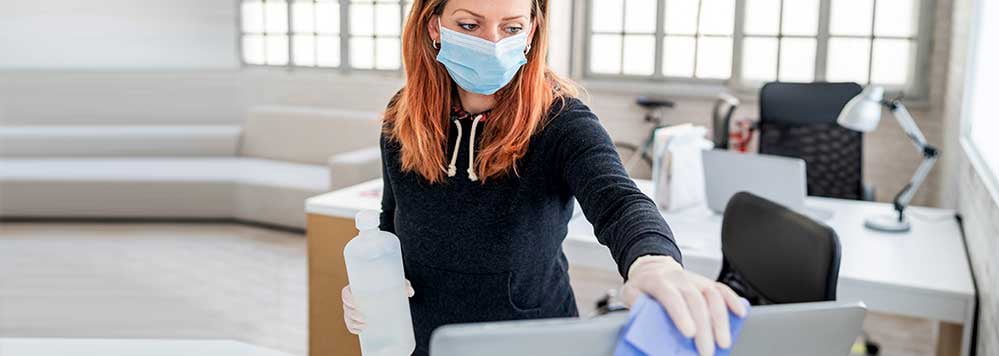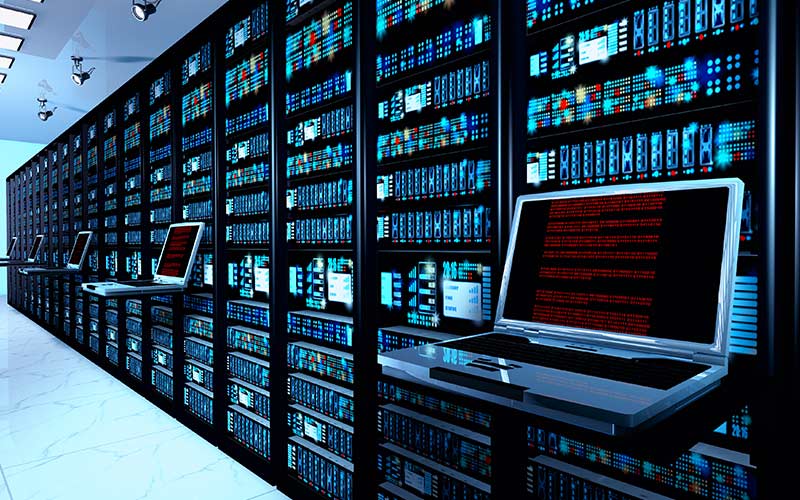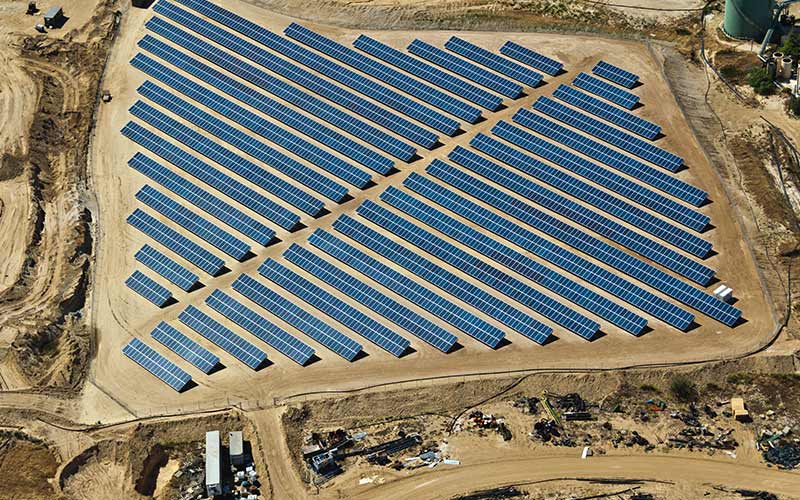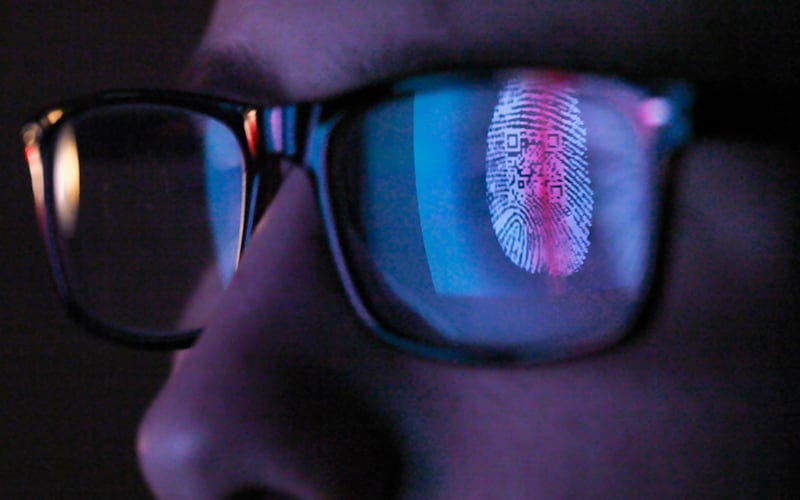Before the pandemic, employees’ primary concerns were deadlines, collaborating with colleagues, and leaving work on time. Now employees focus on isolating themselves from others, wondering if someone may be infected, and limiting the distraction that is the COVID-19 pandemic. As employees return to work, it is imperative that everyone be more cautious than they were pre-pandemic. As countries reopen, smart space solutions have a vital role to play in building safe, nurturing, and resilient workspaces.
The situation at hand
The COVID-19 pandemic disrupted the economy and changed the workplace as we knew it. The economy was turned off. It was hit harder than during the Great Recession of 2008-2009, with millions of people sheltering at home, furloughed, or laid off. As of May 5, the unemployment rate in the United States was officially 14.7% but estimated to be higher. Establishments ranging from local restaurants to large corporations like J. C. Penney Co. have begun to shutter or file for bankruptcy. People are anxious to get back to work and company leaders want to restart operations.
Governments from national levels to local levels issued quarantine restrictions intended to flatten the curve and slow the spread of the coronavirus. Recently, governments have started to ease quarantine restrictions, allowing companies to reopen and bring employees back to work. The opportunity to work and generate income seems like the action needed to restart the economy and protect people’s livelihood. However, people are anxious.
Figure 1. The new realities of the post-pandemic workplace

Source: Infosys
The scientific community is worried
Scientists believe there will be a resurgence of COVID-19, which could undo the success of shutdown restrictions. To offset the financial impact of pandemic shutdowns, states and countries have begun to reopen. In the United States, many areas are reopening even as the number of new cases rises. The much-feared ‘second wave’ of infection may not wait until fall, many scientists say, and instead may become a storm of wavelets breaking unpredictably across the country.1
Reopenings are continuing regardless of research from the scientific community. The question is now whether the businesses and governments will be able to minimize damage from new cases by adopting smarter tactics.
Are workplaces safe?
As different locales begin to reopen, millions of people are faced with a dilemma: should they go back to work and risk their health, or protect their health and risk losing work? (see Figure 1.) This virus scares people, and it does not appear to be leaving anytime soon. Individuals are left to to sort out questions like, if they go back to work, will they get sick and infect their families? If they refuse, will they lose their job and their livelihood? What happens to their unemployment benefits?2
The meatpacking industry, often an afterthought for consumers, has become front-page news because it has become a hot spot for coronavirus cases.3
Large portions of the U.S. population and others still support shutdown orders. Steadily rising unemployment rates since the start of the pandemic have created an urgent need for income — for both individuals and companies.
What are companies currently doing?
Companies at large are trying to mitigate the risks of COVID-19 through new but inefficient practices. States, countries, and businesses have taken different approaches, including requiring the following:
Extended use of personal protective equipment (PPE): Governments and businesses created recommendations for wearing PPE, such as face masks and gloves, while at work or when out in public to limit exposure to the coronavirus. Plexiglas guards and barriers have also been erected in establishments such as gas stations and grocery stores to protect employees and patrons alike.
Sanitizing: People are encouraged to clean surfaces multiple times per day, and many businesses require patrons to sanitize their hands before entering the store. Individuals are instructed to thoroughly sanitize their hands multiple times per day, especially after being in public.
Social distancing: All businesses have implemented social distancing in their workplaces. For the public, this means limiting the number of people in stores and using taped markings to show where to stand to be six feet from other people. Even governmental bodies have implemented social distancing when in session.
Limited testing and screening: Some people are being tested for COVID-19 and must prove they do not have it before they can enter workplaces. While this is not widespread, employees are also being screened for symptoms of the virus in lieu of testing.
What are the limitations of these solutions?
Solutions such as wearing PPE and practicing social distancing mitigate virus exposure, but they fall short because of their inefficient nature and dependence on behavioral changes. These inefficient processes place responsibility on people to self-monitor and self-report symptoms and cases of COVID-19. To monitor these areas and secure the workplace, someone must monitor people and spaces 24/7. If not performed correctly, 24/7 monitoring can cause fatigue and lapses in judgment that lead to virus spread.
At the same time, companies do not have a proven or standard set of processes for reopening workplaces during an active pandemic. Almost no one foresaw a virus that could rapidly shut down the economy and turn the workplace into a place of fear.
Holistic approach to creating safe workplaces: Prepare, prevent, protect, thrive
Enterprises need a structured approach to ensure the workplace is safe and nurturing for workers and resilient in the face of disruptive events like the COVID-19 pandemic. Over the past few months, people have experienced isolation from the workplace through remote work, or from being furloughed or laid off. Through eased quarantine restrictions, companies can rehire and bring back their workforces. To do this, CXOs must follow a process that ensures the safety and well-being of their people (see Figure 2). First, companies need to prepare the workforce and workplace for the return to work. People will judge a company as empathetic or not by how they facilitate the return to work.
Second, companies must prevent the recurrence of COVID-19. Enterprises need to take a data-driven approach to decision making. They need insights into questions like, is it safe to reopen, what is happening in our city, which employees should return, are employees showing symptoms, and what should I do if a person tests positive for COVID-19?
Third, companies need to embrace automated and efficient processes to protect employees as they work. COVID 19 has been the catalyst for people changing their behavior overnight. But the pandemic has also caused fatigue; enterprises must design intuitive experiences and processes for returning to work. The ensuing lockdowns have given everyone an opportunity to reset — individuals and enterprises must use this opportunity to reset well.
Fourth, enterprises need to plan for a return to higher performance — a state in which they will thrive, giving people back their momentum and flow so they can perform their best work. Employee-first companies will redefine business value, make thriving their competitive advantage, and build lasting resilience.
Figure 2. The future of safety in the workplace is prepare, prevent, thrive
Source: Infosys
Embrace technology solutions to build safe nurturing and resilient workplaces
To create a safe, nurturing, and resilient workplace, companies need to explore enabling technology with renewed urgency. Based on many client discussions, emerging approaches include automated body temperature testing, video analytics for social distancing, contact tracing, contactless biometrics, healthy building operation, and workplace analytics.
Automated body temperature testing
The risks of manually testing body temperature include employee exposure and crowd buildup. Companies can automate the process of thermal scanning of employees and customers to identify who has an elevated body temperature (EBT) that indicates illness.
Temperature-sensing cameras enabled with artificial intelligence (AI) provide real-time automated temperature measurement using the following process (see Figure 3):
The camera, equipped with thermal sensors, scans the point of interest.
The thermal image is processed on an EDGE device and AI models identify humans in camera view.
Images are examined immediately and are not stored.
If the body temperature is above a set EBT, an alert is raised, directing the person for further medical screening.
Once a person is confirmed positive for the coronavirus, contact tracing can help companies track the area of influence of the employee. This technology traces back the relevant users who were exposed to the infected person.
Figure 3. Automated body temperature testing to protect employees
Source: Infosys
Video analytics for social distancing
Video analytics is an intelligent technology that checks distances between people in real time (see Figure 4). Video analytics leverages deep learning algorithms to also detect face mask compliance of employees.
These algorithms send alerts to facility administrators when masks are not detected or when social distancing is not followed so interventions can be made.
Figure 4. Social distancing data analytics monitors compliance in real time
Source: Infosys
Contact tracing
Enterprises can use wearables to trace contacts within the enterprise.
For instance, Infosys partnered with Rhode Island state government to launch a contact tracing solution for Rhode Island state — called CRUSH COVID.
Leveraging existing Infosys technologies (see Figure 5), the company developed a mobile app that helps Rhode Islanders follow required health and safety guidelines, monitor their own activities, and support the Rhode Island Department of Health by providing accurate data with user consent. The application, called “CRUSH COVID RI,” utilizes a location-based services platform to create individualized location diaries while protecting user privacy. The mobile app will serve as a one-stop shop for pandemic response, connecting Rhode Islanders with resources about quarantine and isolation supports, symptom monitoring, and up-to-date disease information from the Rhode Island Department of Health.
Figure 5. Contact tracing process in practice
Source: Infosys
Contactless biometrics
While distancing and face masks help prevent infection, companies must take a proactive approach to ensure the building surfaces are safe for employees. Contactless biometrics enable employees and visitors to enter workplaces without touching frequently touched surfaces.
Facial recognition can be used as a contactless biometric for access control, contactless payment, and elevator access, among other uses.
Healthy building operation
When operated smartly, buildings and closed workspaces can help us fight against the spread of COVID-19. United States Green Building Council (USGBC), The WELL Building Institute, and Fitwel provide standards to help reduce the risk of contamination, cleaning protocols, and material selection.
Building facility managers must ensure foundational aspects of a healthy building like workspace air quality, thermal health, moisture, water, nourishment, acoustics, and lighting are up to standard. They need to define new processes for running air conditioning and ventilation. In addition, it is critical to have improved sanitizing protocols in place and train cleaning staff on new procedures. Building IoT and AR technology can augment management of these aspects. These technologies collect data from various building devices and provide visibility to data and downstream analytics to help them make decisions.4
Workplace analytics
Workplace analytics can enforce occupancy restrictions in an office space as determined by local laws. Occupancy data (e.g., people-count data generated by infrared sensors, digital or thermal cameras) can be used by facility managers to identify occupancy violations and by employees to plan for arrival in common places like food courts and exits — in real time.
Workplace analytics helps real estate teams track metrics and automate sanitation workflows and contactless elevator workflows.
Human-centered solutions to nurture a feeling of safety
Companies need to demonstrate empathy for their customers and employees to convey a feeling of safety in the spaces the workspace. Occupants must have the power of information and control of their space. As an extension of workplace analytics, data will help schedule room bookings or trigger sanitation requests (see Figure 6), giving employees peace of mind.
Data can be analyzed and pulled into different dashboards suited to each persona. CXOs/managers can view data and see exception-based alerts matched to their needs. This is possible when a single source of truth is available with centralized data processing, which can be pulled into multiple APIs.
Figure 6. Solutions customized to user needs
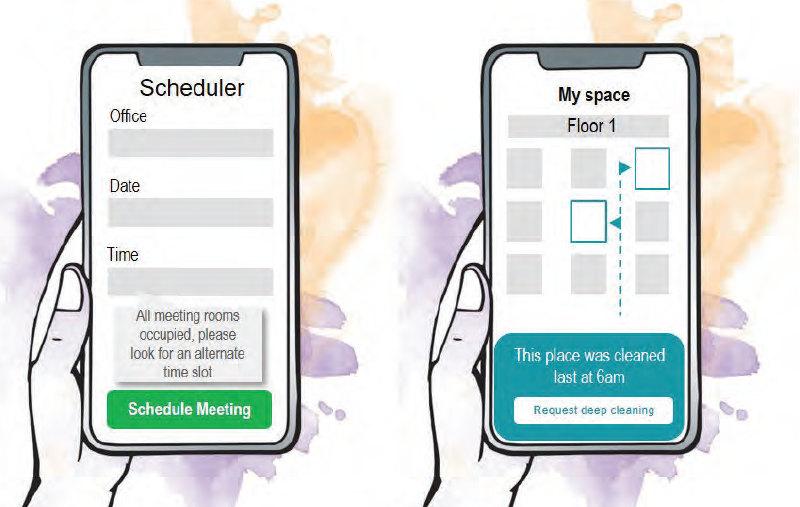
Source: Infosys
Craft your return-to-workplace strategy with data and technology
The “new normal” workplace is going to be different. It is also going to be somewhat unpredictable. People will alternate between working from home to working from office as the pandemic plays out over the medium term. Take a holistic approach, build your strategy around employee and customer safety. Focus on data-driven decision making that allows regular compliance reporting, which will become the norm. Remove human error and focus on automating processes that allow you to be proactive, and provide safe, productive environments for employees. Don’t get stuck in ROI calculation — the damage a potential spread of infection in your workplace can cause to your employees, your customers, and your brand is immense.
Figure 7. Infosys return-to-workplace playbook and solutions
Source: Infosys
Conclusion
The COVID-19 pandemic has demonstrated that companies of all sizes lacked concrete plans for bringing in evolving safety measures at work. While we dealt with the first wave with lockdown and shelter at home, future waves will call for us to continue with our lives and livelihood. The opportunity to reset and implement new safe practices is now. Enterprises have a duty to their employees to build their workplaces to be safe, nurturing, and resilient in the post-pandemic world.
As more companies and businesses begin to reopen workplaces, we strongly urge you to put critical measures in place that will last in the medium term and add resilience to your operations. Enterprises must embrace a prepare, prevent, protect, and thrive framework supported by technology, and they must make data-driven decisions as people return to work.
References
- As States Rush to Reopen, Scientists Fear a Coronavirus Comeback, Donald G. McNeil Jr., May 11, 2020, nytimes.com
- Your Life or Your Livelihood: Americans Wrestle With Impossible Choice, Sabrina Tavernise, Jack Healy and Nicholas Bogel-Burroughs, May 1, 2020, nytimes.com
- Why Meatpacking Plants Have Become Covid-19 Hot Spots, Megan Molteni, May 7, 2020, wired.com
- The next version of the WELL Building Standard™, wellcertified.com
